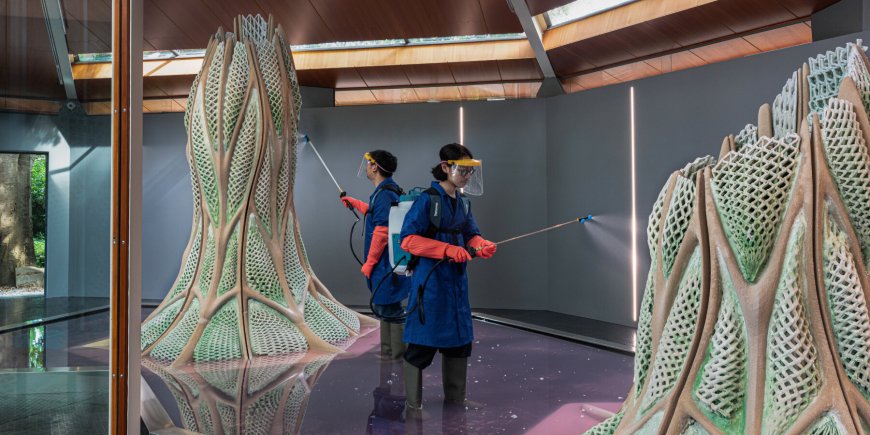Breathing Walls: Swiss Scientists Develop Living Building Materials That Capture Carbon Emissions
Scientists at ETH Zurich have developed living building materials using cyanobacteria that capture CO₂ while forming structural surfaces—ushering in a new era of carbon-negative architecture.

A New Era in Green Architecture: Materials That Live and Breathe
In a groundbreaking development that merges architecture, sustainability, and microbiology, researchers at ETH Zurich have unveiled a living building material that actively captures carbon dioxide from the air. Infused with cyanobacteria, the bioengineered compound is 3D printable, structurally sound, and capable of growing over time—making it a potential game-changer for the global construction industry and the planet.
At a time when the building sector accounts for nearly 40% of global carbon emissions, this innovation presents a compelling new frontier: structures that are not only carbon-neutral but carbon-negative.
“We’re not just building structures anymore—we’re building ecosystems,” said Dr. Veronika Zuber, one of the lead researchers on the project.
The Science Behind Living Building Materials
ETH Zurich’s team developed this material by embedding cyanobacteria—photosynthetic microbes known for their role in producing Earth’s early oxygen—into a biocompatible hydrogel. When exposed to light, these organisms carry out photosynthesis, pulling in CO₂ and releasing oxygen, just like plants.
Key Features of the Material:
-
CO₂ Absorption: Continuous carbon capture through microbial activity
-
Self-Sustaining Growth: Organisms reproduce and spread within the matrix
-
Printable Architecture: Can be 3D printed into complex, functional shapes
-
Durability: Reinforced with sand and mineral compounds for strength and weather resistance
The result is a scalable, low-impact building block that could one day replace concrete or exterior cladding panels.
How It Works: Merging Biology with Structural Engineering
The process starts with a gel-like base composed of biopolymers, which acts as a nurturing environment for cyanobacteria. Using a custom-built 3D printer, researchers shaped the gel into modular patterns that are exposed to controlled light and moisture.
As the material cures and hardens, the cyanobacteria remain alive and functional—continuing to photosynthesize as long as light and humidity are sufficient. What makes this technology revolutionary is its dual performance:
-
Structural integrity comparable to early-stage concrete
-
Biological activity that reduces atmospheric CO₂
Potential Applications in Architecture and Urban Planning
This innovation isn’t limited to experimental buildings. The ETH Zurich team envisions the material being used in:
1. Façade Systems
Buildings could have living skins that change with the seasons while cleaning the air.
2. Green Roof Tiles
Replacing traditional roofing with this material could dramatically increase urban carbon capture capacity.
3. Noise Barriers
Highways and rail lines could adopt carbon-capturing barriers made from these living materials.
4. Public Infrastructure
Bus stops, benches, pavilions, and even sculptures could serve dual purposes as climate tech.
Environmental and Economic Implications
With nations under pressure to meet their Net Zero goals, this breakthrough arrives at a pivotal moment. Unlike conventional carbon capture systems—which are often large-scale and energy-intensive—these materials function passively and continuously.
Environmental Benefits:
-
Passive CO₂ reduction in urban areas
-
Increased biodiversity in architectural design
-
Reduced heat island effect through living surfaces
Economic Potential:
-
Lower material production emissions
-
New industries centered on bio-based architecture
-
Job creation in biofabrication and construction tech
“This is more than sustainability. It’s regenerative architecture,” said Dr. Zuber.
Challenges Ahead: Living Materials in the Real World
Despite the optimism, several hurdles remain:
-
Climate Sensitivity: Cyanobacteria require moisture and specific temperatures to thrive
-
Longevity: Long-term durability in extreme climates is still being tested
-
Regulations: Building codes do not yet account for living materials
-
Public Acceptance: Many may be hesitant to embrace buildings made of “living” components
However, trials in controlled outdoor environments have been encouraging. Researchers are now working with architects and city planners to develop pilot projects across Europe, including green pavilions for the 2025 World Design Forum in Geneva.
The Global Outlook: A Blueprint for Carbon-Negative Cities
The idea of living buildings once seemed confined to science fiction. But with this innovation from ETH Zurich, the concept is transitioning from lab bench to blueprints. If widely adopted, cities of the future could become self-regulating ecosystems, where buildings not only serve people but also heal the environment.
This milestone shows how cross-disciplinary collaboration—biotechnology, architecture, and climate science—can yield radically new solutions to the world’s most urgent problems.
“We’re not just imagining green cities anymore. We’re building them—literally, from the ground up.”











